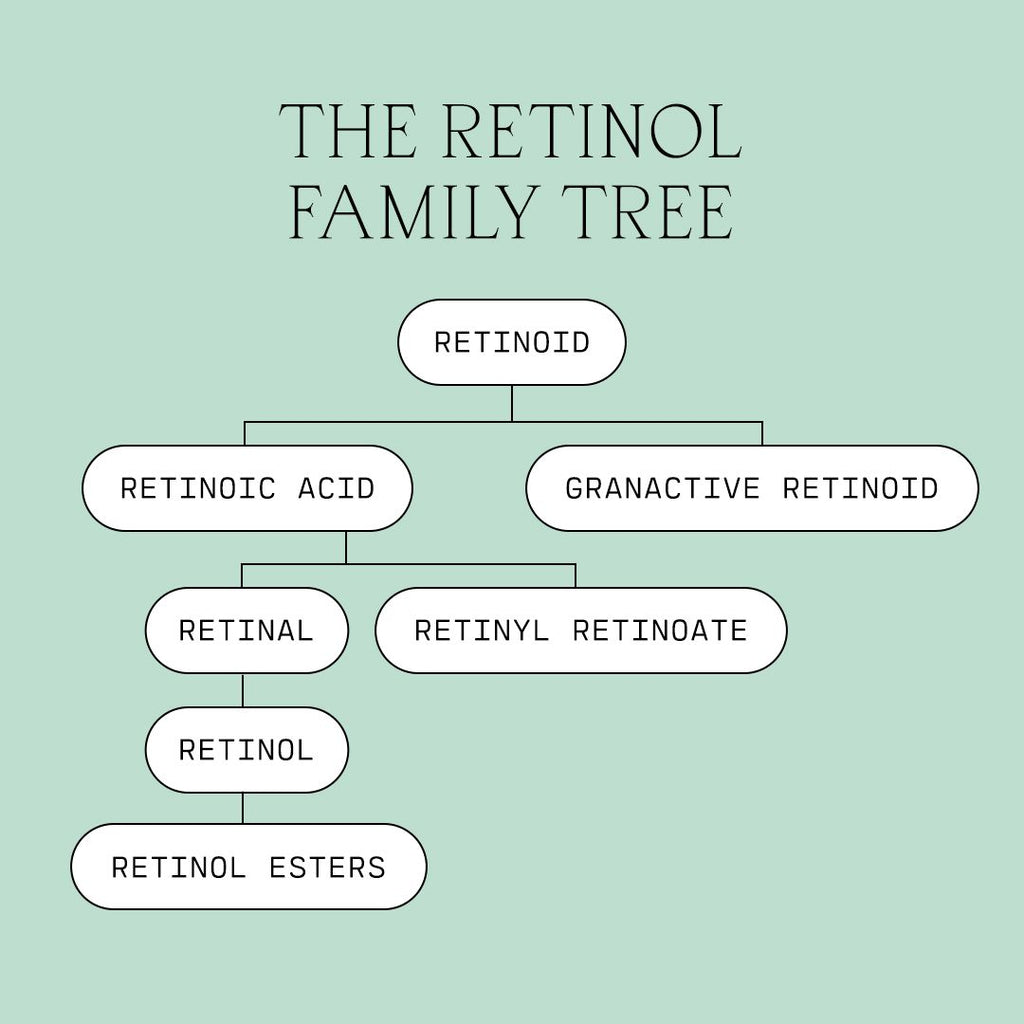
The Different Types of Retinol, Explained
Retinol has rightfully earned its reputation as a top-performing ingredient for aging skin, but did you know it was initially developed as a treatment for acne? Chemists created the first form of retinol in the 1930s but discovered it easily degraded when exposed to light and air. While on a pursuit to find a more stable version, experts discovered the retinol we know and love today; one that helps breakouts, yes, but also smooths wrinkles, firms skin, and delivers a more glowing, youthful complexion.
Throughout the years, many forms of retinol have been developed: over-the-counter and prescription, highly potent and gentle. Because navigating the types of retinol can get complicated, we break it all down for you below. 
Note: Retinol is not recommended for those who are pregnant or nursing. For mamas with aging skin concerns, try ferulic acid. For acne, use niacinamide.
RETINOIDS, RETINOL, AND RETINOL ESTERS
Before we dive into the types of retinol, let’s explain exactly what they are. Retinoids are a class of vitamin A derivatives. Retinol is a type of retinoid. There are many kinds of retinoids and retinol, which we’ll explain later.
No matter which retinoid you choose, they all need to be converted to retinoic acid to work. Retinoic acid binds to retinoid receptors in our skin, speeding up cellular turnover rate and thus, smoothing out lines, brightening dull skin, and controlling acne. The problem? Pure retinoic acid can be too harsh for most skin types. Instead, scientists developed other forms of vitamin A that had to be converted a few times before eventually turning into retinoic acid and delivering those skin-changing results. The more conversions, the longer it takes, and the gentler it’ll be on the skin.
Keep this in mind as you explore the many types of retinoids below.
RETINOIC ACID (TRETINOIN)
Remember: Retinoic acid is the purest form of retinol. Since it doesn’t need to be converted, it gets to work right away. That also means it can be harsh, drying, and irritating for most skin types. Because of this, it requires a prescription known as Retin-A or Retirides for the UK.
TAZAROTENE
This is another prescription-strength retinol that has potential side effects. It doesn’t activate quite as many receptors as retinoic acid does, so it’s slightly less effective, particularly for acne.
ADAPALENE
Tazarotene and adapalene are often compared, as they are similar. The main difference is that adapalene is offered over the counter—it can still be irritating though, so check with your doctor first if you have sensitive skin.
GRANACTIVE RETINOID (HYDROXYPINACOLONE RETINOATE)
This retinoid is on the newer side, and it has many positive attributes that make it one to watch. Similar to retinoic acid, it does not need to be converted and is incredibly effective. Granactive retinoid is much, much less irritating than tretinoin, however, and it doesn’t require a prescription. That's why we formulated it in our Smooth Landing Advanced Retinoid Eye Balm.
RETINAL (RETINALDEHYDE)
Now we’re heading into the types of retinoids that require conversion (a.k.a. less potent, less potential for irritation) and are available over the counter. Retinal (we know, the spelling is confusing) is just one conversion step from retinoic acid.
RETINYL RETINOATE
Retinyl retinoate takes one conversion, too, but it’s a little unique. It converts to part retinoic acid, part retinol (see below).
RETINOL
Convert retinoic acid twice and you have the retinol. It’s the most well-known type, found in a majority of retinol-based skincare products.
Sometimes, formulas will use encapsulated retinol. That just means the retinol active is wrapped in a protective coating that only releases the retinol inside once it has passed skin’s surface, which reduces the possibility of irritation. Get the benefits of encapsulated retinol by using our Gentle Retinol Serum and Retinol Body Lotion.
RETINOL ESTERS
Retinol esters take three conversions to reach retinoic acid. They are a bit special because they require another molecule to work. The effectiveness of esters relies on the effectiveness of the molecule selected, noted in the name. For example, retinyl palmitate is an ester of vitamin A and palmitic acid.
*BAKUCHIOL + AROPHIRA
Technically, neither of these ingredients are retinoids, since they don’t contain any vitamin A. Rather, they are derived from plants, but they earned their spot on this list because they deliver retinol-like benefits for both acne and aging skin. Arophira helps reduce sebum, unclogging pores and preventing breakouts. Bakuchiol (our bakuchiol is CITES certified, meaning its use doesn’t negatively impact the species' survival) promotes elasticity and firmness while reducing the appearance of fine lines and hyperpigmentation.
Out of all the types of “retinol,” these plant-based alternatives are the gentlest, which makes them ideal for first-time retinol users or those with sensitive skin.
Shop retinol skincare below.






